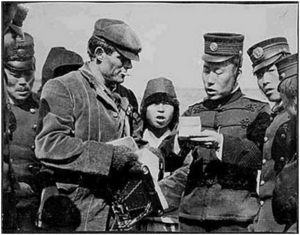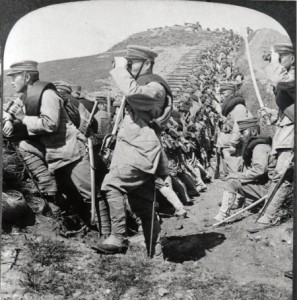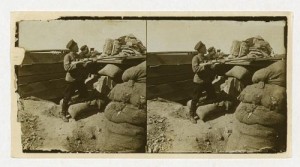Photography and the Russo-Japanese War
Posted: February 5th, 2014 | 2 Comments »Following on from yesterday’s post on foreign journalistic coverage of the Russo-Japanese War of 1904-05, another excerpt from my book, Through the Looking Glass, on the role of photography during the war, another reason the generals of 1914-1918 shouldn’t have been so surprised by events during WW1.
Photography and the Russo-Japanese War
 Jack London with Japanese Officers in Korea during the Russo-Japanese War
Jack London with Japanese Officers in Korea during the Russo-Japanese War
As it was for modern warfare, the Russo-Japanese War was revolutionary for modern photography. While stereoscopic slides had been about during the Boxer Rebellion and the Spanish-American War, the Russo-Japanese War was perhaps their major introduction to mass appeal. Arguably the strongest images of the war came from the Russian “Photographer to the Czar†Sergei Mikhailovich Prokudin-Gorskii. He was both the official photographer for the Russian side on the Manchurian battlefield and for the Trans-Siberian Railway project.
The war was photographed in graphic style — which showed clearly that by 1905 editors understood the value of gory pictures — with images of Shenyang and Port Arthur sent around the world. Self-taught photographing brothers Elmer and Bert Underwood produced box sets of stereographs from the war, including a striking shot of Japanese soldiers carrying out an execution. Jack London and James Ricalton sent photographs, which demonstrated that war correspondents were now sending images as well as text and pioneering photojournalism in China. Ricalton sent back amazing shots for the time and was given virtually unparalleled access for a foreigner to the Japanese forces. Herbert Ponting, an Englishman who had emigrated to America in his early twenties, went to the war as Harper’s Weekly’s correspondent and later returned to travel around Japan, India, China, Korea, Java and Burma. He too sent back pictures as well as text. Ponting was later the official photographer on Scott’s British Antarctic Expedition.
 An Underwood and Underwood picture of a Japanese trench
An Underwood and Underwood picture of a Japanese trench
The Russo-Japanese War was also the first time spies posing as journalists used photography. Some were found to be smuggling secret reports in micro-photographic form and the war provided evidence of the increasingly shady links between journalism and espionage. The Russians later revealed that they had obtained information on Japan’s strategy, including the plan for the major offensive in Manchuria in March 1905 that Jack London witnessed, through a Tokyo-based French correspondent, a Monsieur Balais of Le Figaro. Through the mysterious Frenchman, Russia found out in August 1904 that Japan would attack Shenyang, which was under Russian control at the time, as early as January 1905. Alexander Pavlov, a senior Russian diplomat in Korea, had apparently hired Balais who had begun his espionage career in Shanghai a couple of years earlier. Balais sent around 30 reports to Pavlov in Shanghai by regular sea mail.
A James Ricalton “stereo card” of Tsarist and Japanese troops
Film cameras were also in evidence now too. George Roberts filmed the Russian army marching from Siberia to Manchuria, securing notable images showing the beheading of a Chinese bandit, while Joseph Rosenthal filmed on the Japanese side for the Charles Urban Trading Company. Rosenthal had already filmed the Boer War, travelling with Lord Roberts’s column, as well as the American occupation of the Philippines. At the same time, correspondents also did deals with local photographers, even buying pictures from the photographic unit of the Japanese Imperial General Headquarters and from Japanese photographers such as Koson Ohara who produced prints similar to those that had proved popular during the earlier Sino-Japanese War.
After 1905, wherever foreign journalists were to be found in China, photographers would also be constantly present, and shortly after that newsreel cameramen also. The China story was now to be one of text and images together.
An Underwood and Underwood image of the Siege of Port Arthur (Lushun)


I’m writing an article, focusing on James Ricalton’s Life and Work. I intend to publish Ricalton stereographs full size ( 3 1/2 x 7) and give readers of our SLCHA Journal an inexpensive stereo viewer. Thanks for the “Through the Looking Glass” review. Please alert me to anything else Ricalton you may have. Roger Bailey Canton, New York
I’m not sure my first reply was sent. I said:
I’m writing an article of James Ricalton, His Life and Work, with intent to publish some of his stereographic photos, life size, (3 1/2″ x 7″) and give readers an inexpensive stereo viewer.
Thanks for your review of “Through the Looking Glass.” Plrase advise me if you have other Ricalton thoughts. Roger Bailey